 The Scouting America's Commitment to Safety is ongoing and we want you to know that the safety of our youth, volunteers, staff, and employees cannot be compromised. Scouting America puts the utmost importance on the safe and healthy environments for its youth membership. The Sam Houston Area Council takes great strides to ensure the safety of its youth as well as the adult volunteer leadership that interacts with them.
The Scouting America's Commitment to Safety is ongoing and we want you to know that the safety of our youth, volunteers, staff, and employees cannot be compromised. Scouting America puts the utmost importance on the safe and healthy environments for its youth membership. The Sam Houston Area Council takes great strides to ensure the safety of its youth as well as the adult volunteer leadership that interacts with them.
Health and safety must be integrated into everything we do, to the point that no injuries are acceptable beyond those that are readily treatable by Scout-rendered first aid.
Few youth organizations encompass the breadth, volume, and diversity of physical activity common to Scouting, and none enjoy a better safety record. The key to maintaining and improving this exemplary record is the conscientious and trained adult leader who is attentive to safety concerns.
As an aid in the continuing effort to protect participants in a Scouting activity, the National Health and Safety Committee and the Council Services Division of the National Council have developed the SAFE Checklist of safety procedures for physical activity. These points, which embody good judgment and common sense, are applicable to all activities.
SHAC ERM Guide for Units SAFE Checklist Guide to Safe Scouting Youth Protection Medical Forms
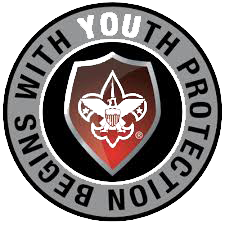 Youth Protection Training (YPT) is designed to help you keep youth safe from abuse. During YPT, participants learn the Youth Protection Guidelines, signs of abuse, and how to report suspected abuse. After each section of material, participants will answer questions about that section’s topic. This course must be completed by all leaders and is highly recommended for every parent and adult working with youth.
Youth Protection Training (YPT) is designed to help you keep youth safe from abuse. During YPT, participants learn the Youth Protection Guidelines, signs of abuse, and how to report suspected abuse. After each section of material, participants will answer questions about that section’s topic. This course must be completed by all leaders and is highly recommended for every parent and adult working with youth.
Youth Protection Training (YPT)
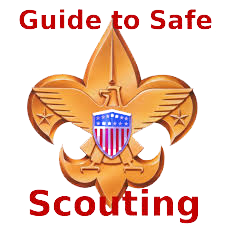 The purpose of the Guide to Safe Scouting is to prepare adult leaders to conduct Scouting activities in a safe and prudent manner. The policies and guidelines have been established because of the need to protect members from known hazards that have been identified through 100-plus years of experience. Limitations on certain activities should not be viewed as stumbling blocks; rather, policies and guidelines are best described as stepping-stones toward an enjoyable adventure. All volunteers participating in official Scouting activities should become familiar with the Guide to Safe Scouting. Unit leaders should be aware of state and local government regulations that supersede policies and guidelines.
The purpose of the Guide to Safe Scouting is to prepare adult leaders to conduct Scouting activities in a safe and prudent manner. The policies and guidelines have been established because of the need to protect members from known hazards that have been identified through 100-plus years of experience. Limitations on certain activities should not be viewed as stumbling blocks; rather, policies and guidelines are best described as stepping-stones toward an enjoyable adventure. All volunteers participating in official Scouting activities should become familiar with the Guide to Safe Scouting. Unit leaders should be aware of state and local government regulations that supersede policies and guidelines.
Guide to Safe Scouting
 In order to provide better care for its members and to assist them in better understanding their own physical capabilities, Scouting America recommends that everyone who participates in a Scouting event have an annual medical evaluation by a certified and licensed health-care provider—a physician (MD or DO), nurse practitioner, or physician assistant. Providing your medical information on this four-part form will help ensure that you meet the minimum standards for participation in various activities. Note that unit leaders must always protect the privacy of unit participants by protecting their medical information. The Annual Health and Medical Record is to be completed at least annually by participants in all Scouting events.
In order to provide better care for its members and to assist them in better understanding their own physical capabilities, Scouting America recommends that everyone who participates in a Scouting event have an annual medical evaluation by a certified and licensed health-care provider—a physician (MD or DO), nurse practitioner, or physician assistant. Providing your medical information on this four-part form will help ensure that you meet the minimum standards for participation in various activities. Note that unit leaders must always protect the privacy of unit participants by protecting their medical information. The Annual Health and Medical Record is to be completed at least annually by participants in all Scouting events.
Annual Health and Medical Record
Health and Safety Training
Scouting America and the council offers a variety of training courses to educate the adult leadership through training courses online as well as in a classroom setting. Additional information is also available in the Guide to Safe Scouting and on the Scouting Safely website.
First Aid/CPR/AED: Would you know what to do in a cardiac, breathing or first aid emergency? The right answer could help you save a life. With an emphasis on hands-on learning, our First Aid/CPR/AED courses give you the skills to save a life. Red Cross First Aid, CPR (cardiopulmonary resuscitation) and AED (automated external defibrillator) training is universally recognized for its effectiveness. It can help ensure that everyone from the Scout working on a First Aid merit badge to a Scouter leading a unit on a high-adventure trek is fully prepared. Find the next scheduled course.
First Aid/CPR/AED Training
Wilderness First Aid (WFA) is the assessment of and treatment given to an ill or injured person in a remote environment where definitive care by a physician and/or rapid transport is not readily available. Participants will learn how to assess, treat, and (when possible) contain emergencies within the scope of their training. Find the next scheduled course.
Wilderness First Aid (WFA) Training
Tools to plan events and campouts
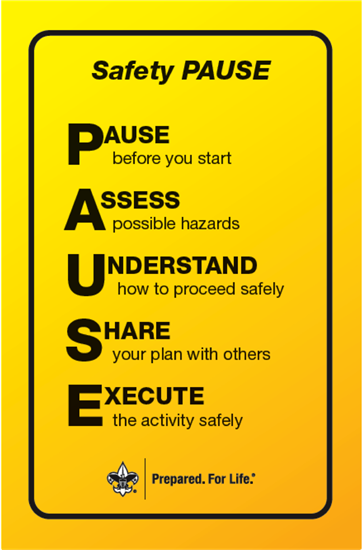 The campout safety checklist provides guidance on safety issues that you may encounter at a Scouting campout. Along with the Guide to Safe Scouting and the tour and activity plan, this tool will help you in having conversations on identifying risks that need to be mitigated or eliminated.
The campout safety checklist provides guidance on safety issues that you may encounter at a Scouting campout. Along with the Guide to Safe Scouting and the tour and activity plan, this tool will help you in having conversations on identifying risks that need to be mitigated or eliminated.
The event safety checklist provides guidance on safety issues that you may encounter at a Scouting event. This is a tool, not a list of mandatory guidelines. The intent of the checklist is to create conversations among event organizers around risks and ways to mitigate or eliminate them.
As an aid in the continuing effort to protect participants in a Scout activity, the National Health and Safety Committee and the Council Services Division of the National Council have developed the SAFE Checklist of safety procedures for physical activity. These 16 points, which embody good judgment and common sense, are applicable to all activities.
Emergency Preparedness
 Emergency management, emergency preparedness, and disaster services are common throughout the United States - we take care of each other. By whatever name, these activities encompass preparedness, response, mitigation and recovery related to any kind of disaster, whether natural, technological, or national security. Emergency preparedness means being prepared for all kinds of emergencies, able to respond in a time of crisis to save lives and property, and to help a community or even a nation - return to normal life after a disaster occurs.
Emergency management, emergency preparedness, and disaster services are common throughout the United States - we take care of each other. By whatever name, these activities encompass preparedness, response, mitigation and recovery related to any kind of disaster, whether natural, technological, or national security. Emergency preparedness means being prepared for all kinds of emergencies, able to respond in a time of crisis to save lives and property, and to help a community or even a nation - return to normal life after a disaster occurs.
The Emergency Preparedness program is planned to inspire the desire and foster the skills to meet this challenge in our youth and adult members so that they can participate effectively in this crucial service to their families, communities, and nation. Please review the linked documents to help your family be prepared for emergencies.
Incident Reporting
A key res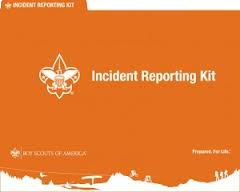 ponsibility that all volunteers and professional staff share is providing an effective program that meets the needs of young people and provides the proper health and safety of everyone concerned. It is important that we sustain the safe operation of our programs and promote continuous improvement through organizational learning. Timely and complete incident reports support analysis that is critical to identifying needed improvement of the programs offered.
ponsibility that all volunteers and professional staff share is providing an effective program that meets the needs of young people and provides the proper health and safety of everyone concerned. It is important that we sustain the safe operation of our programs and promote continuous improvement through organizational learning. Timely and complete incident reports support analysis that is critical to identifying needed improvement of the programs offered.
Mandatory Report of Child Abuse
 All persons involved in Scouting shall report to local authorities any good-faith suspicion or belief that any child is, or has been, physically or sexually abused, physically or emotionally neglected, exposed to any form of violence or threat, exposed to any form of sexual exploitation, including the possession, manufacture, or distribution of child pornography, online solicitation, enticement, or showing of obscene material. You may not abdicate this reporting responsibility to any other person.
All persons involved in Scouting shall report to local authorities any good-faith suspicion or belief that any child is, or has been, physically or sexually abused, physically or emotionally neglected, exposed to any form of violence or threat, exposed to any form of sexual exploitation, including the possession, manufacture, or distribution of child pornography, online solicitation, enticement, or showing of obscene material. You may not abdicate this reporting responsibility to any other person.
Learn More
Steps to Reporting Child Abuse
- Ensure the child is in a safe environment.
- In cases of child abuse or medical emergencies, call 911 immediately. In addition, if the suspected abuse is in the Scout's home or family, you are required to contact the local child abuse hotline.
- Notify the Scout executive or designee.
Reporting Violations of Youth Protection Policies
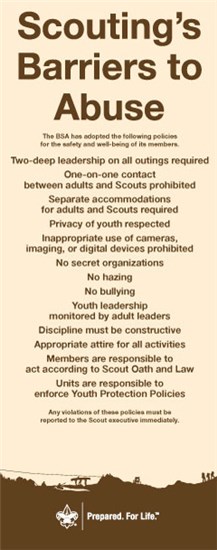 Reports of child abuse may come in many forms. They may be in the form of conversation, phone calls or letters (either anonymous or with the person making the report identified).
Reports of child abuse may come in many forms. They may be in the form of conversation, phone calls or letters (either anonymous or with the person making the report identified).
The most important thing to remember is that all reports of child abuse involving Scouts or Scouters must be reported immediately. If you think any youth protection policies have been violated, including those described within Scouting's Barriers to Abuse, you must notify your district executive, the Director of Support Services, Brandon Lewis (713-756-3319 or brandon.lewis@scouting.org) or Wayne McLeland (713-756-3309, or wayne.mcleland@scouting.org).
All allegations should be kept strictly confidential, with as few people involved and as little discussion about the matter as possible.
It’s the Law: If you believe that a child has been physically or mentally abused or neglected, or that a child has died of abuse or neglect, you must report your suspicion to the Texas Department of Protective and Regulatory Services (PRS) or law enforcement agency.
You must make an oral report immediately to the nearest PRS Child Protective Services (CPS) office or to the 24-hour Child Abuse Hotline at 1-800-252-5400 (voice or TDD). All reports to CPS are given to local law enforcement agencies.
Immunity: If you, without malice, make a report of suspected child abuse or neglect, you are immune from civil or criminal liability.
Confidentiality: Reports of child abuse and neglect are confidential. Information in the reports, including the name of the person who makes the report, may be used only for the investigation of abuse or neglect.
Failure to Report: It is the law in Texas that suspected physical or mental abuse or neglect of a child must be reported. Failure to do so is a crime punishable by fine, imprisonment or both.
The Scout executive or council designee and the person making a report of suspected abuse are required by law to report all suspected cases to the Texas Department of Protective and Regulatory Service (PRS) and/or law enforcement agency.
Scouts First Helpline
The protection of youth is the primary obligation of every individual involved in Scouting America - including leaders, parents, members and professionals. Scouting America has been and will continue to be vigilant in its efforts to create barriers that help prevent abuse and to recognize and report child abuse regardless of where it occurs.
As part of the Scouts First approach to the protection and safety of youth, Scouting America has established "844- Scout1st ”, (844-726-8871), a dedicated 24-hour helpline to receive reports of known or suspected abuse or behavior that might put a youth at risk. (The call may be answered by a person who gathers initial information and escalates the report for further handling based upon the nature of the situation.)
The helpline's goal is to provide immediate assistance to ensure that the victim, unit, and council are fully supported and the actions taken are properly documented. Minor, non-recurring infractions with no indication youth are at risk can still be addressed at the unit or council level.
Nationwide, Scouting America requires everyone involved with Scouting to report any known or suspected abuse to local authorities.
Responding to Abuse: When information regarding known or suspected abuse or behavior that might put a youth at risk is first discovered, the following steps should immediately be taken:
Get the victim medical treatment, if required, and to a place of safety if needed
- Ensure the victim(s) parents are notified as soon as possible
- Notify law enforcement and/or child protective services
- Call the 844-Scouts1st Helpline (844-726-8871)
Reporting Abuse or behavior that might put a youth at risk: Accurate information is critical to an appropriate response; however, a lack of specific information is not a reason to delay a report. At a minimum. every effort should be made to have the following infom1ation available when reporting to the 844-Scoutslst Helpline:
- The name, age, council, and unit of the alleged victim(s)
- The name and phone number of the victim's parent(s)
- The name, age, council, and unit of any other known or suspected victim(s) and their parents contact information
- The name, position, council, and unit of alleged perpetrator(s)
- The name and phone number of the law enforcement or protective service agency to which the incident was reported
- The name, unit, and council of any known witnesses
- The name and phone number of the reporter
- Details of the incident: who, what, where, and when
Scouting America also offers assistance with counseling to any Scout, former Scout, or family member of any Scout who suffered abuse during their time in Scouting. Individuals can email scouthelp@scouting.org or call toll free at 855- 295-1531 to discuss these sensitive matters. Questions regarding the 844-Scouts1st Helpline should be directed to Membership Standards at 972-580-2365 or 972-580-2007.
ScoutsFirst for Counseling and Support
Scouting America is committed to providing ongoing support to victims and their families, including counseling. We want to help victims heal, on their own terms, with a professional counselor of their choice. Through the ScoutsFirst Helpline, Scouting America offers assistance with counseling to any youth member, former youth member, or the family of any youth member who suffered abuse during their time in Scouting. To reach the ScoutsFirst Helpline, call (844)-Scouts1 or (844)726-8871, or email scouts1st@scouting.org. Support is available 24-hours a day, seven days a week.
Alcohol, Tobacco and Drug Use and Abuse Guidelines
The Guide To Safe Scouting Section IV Alcohol, Tobacco and Drug Use and Abuse states:
"An important way adult leaders can model healthy living is by following the policies on alcohol, tobacco, and drugs. Leaders should support the attitude that they, as well as youths, are better off without tobacco in any form and may not allow the use of tobacco products at any Scouting activity involving youth participants. This includes the use of electronic cigarettes, personal vaporizers, or electronic nicotine delivery systems that simulate tobacco smoking.
All Scouting functions, meetings, and activities should be conducted on a smoke-free basis, with smoking areas located away from all participants.
Reference: Troop Leader Guidebook, Volume 1, No. 33009
As outlined in the Scouter Code of Conduct, Scouting activities are not a place to possess, distribute, transport, consume, or use any of the following items prohibited by law or in violation of any Scouting rules, regulations, and policies: alcoholic beverages or controlled substances, including marijuana.
In addition, the Code of Conduct specifies that if you are taking prescription medications with the potential of impairing any functioning or judgment, you will not engage in activities that would put Scouts at risk, including driving or operating equipment." Source
Resources
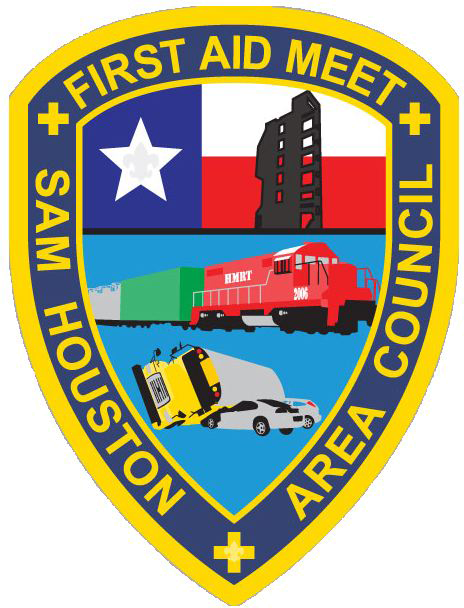
The
council First Aid Meet is an event that challenges Scouts' abilities to perform first aid in simulated real-life situations. Troop patrols compete in practical first aid problems, displaying hands-on skills from the
Scout Handbook, First Aid merit badge pamphlet, and current American Red Cross guidelines. The top patrols at each district’s first aid meet are eligible to compete in the council First Aid Meet. Patrols are given a variety of scenarios and are expected to show proficiency in first aid.
Enterprise Risk Management Committee
The objectives of the Enterprise Risk Management programs are to educate the adult leadership in the available programs through training courses online as well as in a classroom setting. Scouting America and the Sam Houston Area Council have created guidelines to help units:
- Know, understand, and comply with all rules, policies, and procedures.
- Model safe behaviors when participating in Scouting events.
- Encourage staff, volunteer leaders and youth members to share in the management of risk.
- Promote, provide, and, when appropriate, require health and safety training.
- Communicate the importance of incident and near-miss reporting and hold staff members accountable for implementing reporting procedures at unit, district, and council levels.
- Study incidents that do occur to learn from them, and modify risks where appropriate.
- Support enterprise risk management concepts.